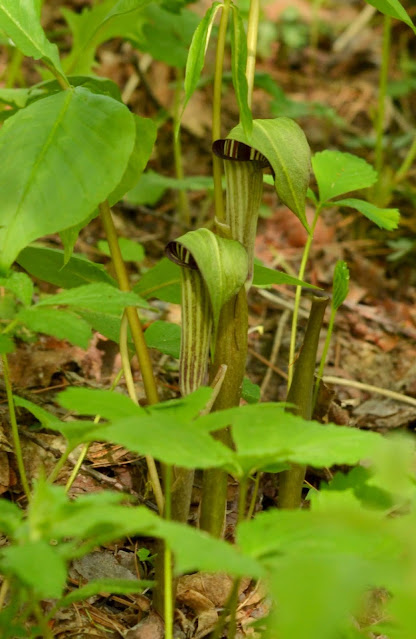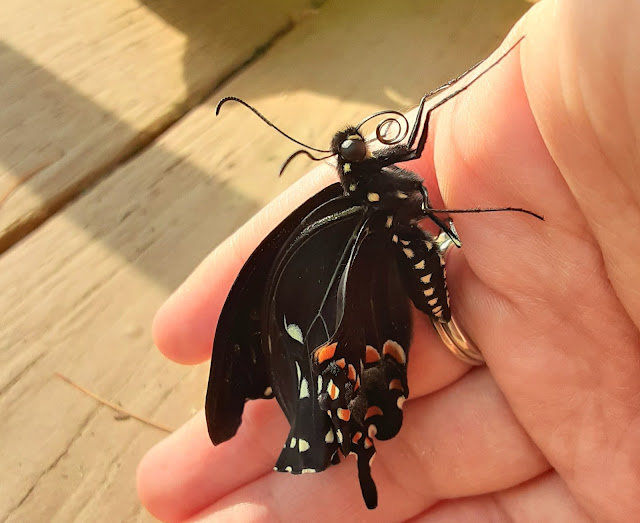When last I shared some sights from around our property -- several months ago, oops! -- it was a green and sunny June. It feels strange to be going back to the height of summer now, when we've just recently passed the Winter solstice, but I can't very well let the second half of the year slip by without highlighting some more of this place's natural goings-on that I love so much. So here are some sights from June and July, 2021!
On June 23, I crossed paths with this male Black-and-White Warbler who snatched up a moth for processing -- I'm pretty sure that's dust from the moth's wings floating around in this picture:
Little colorful creatures in the yard are always fun. Here's a male Ruby-throated Hummingbird showing off iridescent blue/green feathers along his back while visiting hosta blossoms on July 17:
And here's a bright Red Eft (juvenile Red-spotted Newt) making its way across the stone path in front of our house on July 18:
The Eastern Phoebes successfully raised four babies in the nest above our front door, their second brood of the year. On July 16, the babies' eyes were starting to peek open:
And by July 23 the baby phoebes were alert and nearly ready to leave -- I kept my distance for this picture to avoid startling them out of the nest too early; I love seeing the frumpy looks on these little birds' faces when they reach this stage each year:
This lovely Striped Hairstreak (Satyrium liparops) who showed up in our yard on July 8 was a new butterfly for me:
And I love the finely striped pattern on this Mourning Cloak butterfly who was resting on a shed wall on July 16:
On July 21, I found this perfect little cache of Chokecherry berries in the middle of our yard, presumably stored away by a mouse or other little creature for later; the low grass and clover seemed like a strange place to hide food, but oh well:
This small White-spotted Sable (Anania funebris) moth was enjoying some Buttonbush blossoms on July 23:
What a fancy stripey underside this moth has:
Here's another White-spotted Sable on fuzzy Wild Bergamot (Monarda fistulosa) flowers in the meadow on July 28:
Nearby, a Silver-spotted Skipper was also visiting Wild Bergamot blossoms:
And this Eastern Tiger Swallowtail looked extra stunning on Purple Coneflower blossoms:
Meanwhile, this Widow Skimmer hunted from a perch in the sunlit meadow:
One last series of sights from July 28: While walking at the back corner of our meadow, bordering the woods, I must've wandered into the overlapping territories of some very antsy male birds -- perhaps one bird's scolding encouraged the others to come keep a close eye on me as well. In any case, I ended up with some very close looks at three local breeders who usually stay much more hidden and/or distant from me. This male Common Yellowthroat was the first to show himself, popping out of the honeysuckle hedge at the edge of the meadow:
What a fancy guy:
Our resident male Indigo Bunting showed up next -- with his patchy blue-brown-white costume, I assume this is quite a young male, but I'd seen him singing in our meadow at various times this summer, so I suppose he must have successfully established the meadow as part of his territory and had a family hidden somewhere nearby:
And then most surprising of all, an Ovenbird emerged from the woods to perch on an old moss-covered apple branch over the trail and watch me intently:
I don't know for sure whether this was a male or female Ovenbird, but given that the first two birds were territorial males, I assumed that's what was going on here, too:
Either way, this Ovenbird didn't take its eyes off of me while I was in the area, and it stayed quite close:
What a treat to see one of our resident Ovenbirds so close-up, and it was being such a good lookout -- all three of these birds did a great job, really, and I felt lucky to meet them:
I had the trail camera running in the woods throughout June and July (and then I neglected to set it up for the rest of the year), so here are a few video clips from our woods trail when no people were around:
1. A Raccoon pausing to survey the woods at night.
2. A mother White-tailed Deer with her baby, the mother making soft raspy vocalizations (what was she saying?).
3. A young White-tailed Deer (the same one from the previous clip?) getting close to the camera.
4. An Ovenbird picking out a morsel (a caterpillar?) from the forest floor.
Every year continues to be a mixture of increasingly familiar sights and new surprises. There's more to share from 2021, so that'll be the next post!










































































